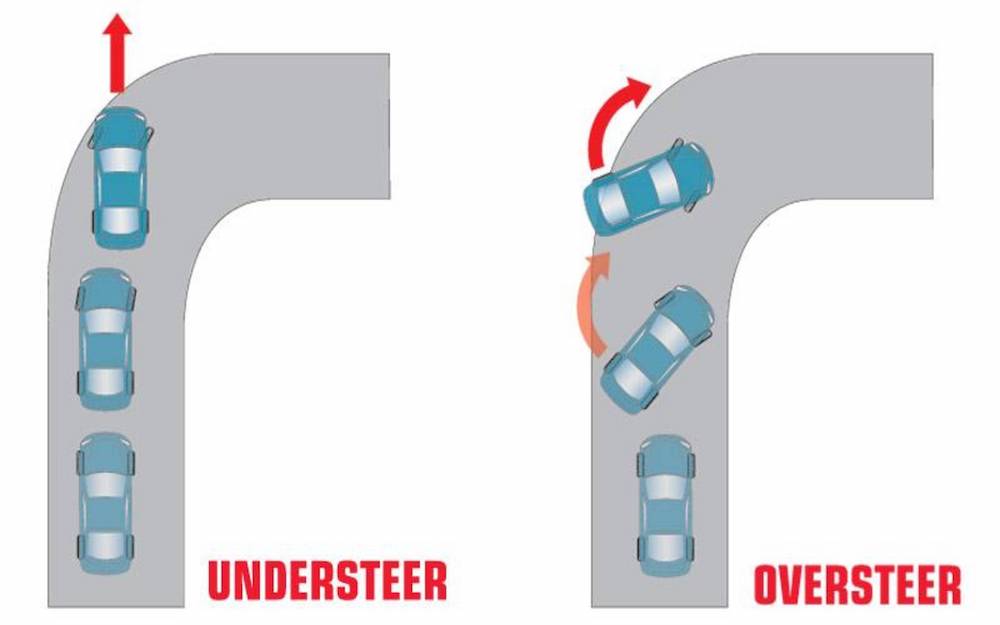
Oversteer and understeer are two terms commonly used in the automotive world, especially when it comes to talking about performance. BMW models are known to be tail happy due to their rear wheel drive bias which creates oversteer. Below we will go over the differences and advantages of both performance characteristics.
What is understeer?
Understeer is simply the result of the vehicle turning less than expected from the driver’s input. Understeer typically causes the vehicle to slide off the road in a turn. The vehicle slides forward despite the steering wheel being turned. Understeer is more common in front-wheel drive vehicles. This is due to the front wheels having to deliver power, maintain direction, brake, and maintain traction. This is a lot to ask for compared to rear-wheel-drive vehicles. See image below for further clarification.
What causes understeer?
Understeer is most commonly caused by the driver entering a corner at too high of a speed for the vehicle’s setup. The front wheels lose grip, causing the vehicle to slide straight rather than turning direction. The solution to fixing the understeer is to enter the corner slower or to add more front grip to the vehicle to prevent sliding.
What is oversteer?
Oversteer is simply the result of the vehicle turning more than expected from the driver’s input, most commonly found in rear wheel drive vehicles. This typically causes the vehicle to spin out by the back end kicking forward. See image below for further clarification.
What causes oversteer?
Oversteering occurs when too much power is sent to the wheels than it can handle. Oversteering is typically undesirable, however, the controlling of a vehicle’s oversteer is commonly seen in power-sliding or drifting of cars. This controlled oversteer holds the at the threshold of grip while preventing the back end from completely spinning the vehicle around.
What are the advantages and disadvantages?
Understeer advantages:
➊ More stable than oversteer
➋ Less harsh on tires than oversteer
➌ Safer in the rain
Understeer disadvantages:
➊ The vehicle is less responsive than oversteer
➋ Slower turn-in speeds
Oversteer advantages:
➊ Faster turn-in speeds
➋ Faster cornering speeds than understeer
Oversteer disadvantages:
➊ More unstable than understeer
➋ Harsher on tires than understeer
Why is understeer and oversteer important?
Too much of either is not ideal. It is the difficult responsibility of automakers to fine-tune the performance of their vehicles to have the perfect combination of understeer and oversteer in various conditions to ensure driver safety. With the advances in modern electronics in vehicles, understeer and oversteer can be managed to safely drive vehicles around corners in all types of environments.
Most BMW drivers prefer slight oversteer, which is ideal for the classic rear-wheel drive setup. With the increasingly common all-wheel drive, X-Drive function of BMW models, oversteer is being corrected by adding front-wheel drive in combination with rear-wheel drive. Modern M cars equipped with M X-Drive are capable of disconnecting the front-wheel drive system leaving the rear wheels delivering all the power. This changes the driving dynamics of the vehicle at the press of a button and allows for more versatility in the driving characteristics of the vehicle. Normal road use typically engages the M X-Drive system for safety, while disengaging the front wheels on the track will provide for more playful (and more dangerous) handling characteristics.

IMG SOURCE: Autoweek.com
Where can I learn more BMW fun facts?
Learn more BIMMERtips fun facts by clicking HERE



